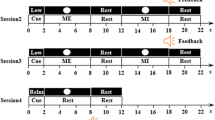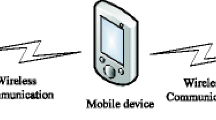Abstract
Due to the non-stationarity of EEG signals, online training and adaptation are essential to EEG based brain–computer interface (BCI) systems. Self-paced BCIs offer more natural human–machine interaction than synchronous BCIs, but it is a great challenge to train and adapt a self-paced BCI online because the user’s control intention and timing are usually unknown. This paper proposes a novel motor imagery based self-paced BCI paradigm for controlling a simulated robot in a specifically designed environment which is able to provide user’s control intention and timing during online experiments, so that online training and adaptation of the motor imagery based self-paced BCI can be effectively investigated. We demonstrate the usefulness of the proposed paradigm with an extended Kalman filter based method to adapt the BCI classifier parameters, with experimental results of online self-paced BCI training with four subjects.





Similar content being viewed by others
Notes
According to our experience, all subjects prefer to perform the next mental task before the end of the refractory period, while they see the robot (see Sect. 2.4) is about to reach the next node.
In that study, nine subjects participated in an offline BCI experiment. Five were invited for further online experiment, but only three agreed and only two of them were able to control the online self-paced BCI system at a reasonably satisfactory level.
For this experiment, the initial setting for threshold is 0.5, and 1.5 s for dwell time. The first author is the only experiment conductor.
In our experience, subjects usually found themselves easier to control one class over another class, so it is reasonable to assign threshold and dwell time differently.
References
Birbaumer N, Ghanayim N, Hinterberger T, Iversen I, Kotchoubey B, Kübler A, Perelmouter J, Taub E, Flor H (1999) A spelling device for the paralyzed. Nature 398:297–298. doi:10.1038/18581
Birch GE, Bozorgzadeh Z, Mason SG (2002) Initial on-line evaluations of the LF-ASD brain–computer interface with able-bodied and spinal-cord subjects using imagined voluntary motor potentials. IEEE Trans Neural Syst Rehabil Eng 10(4):219–224. doi:10.1109/TNSRE.2002.806839
Blankertz B, Müller K-R, Krusienski DJ, Schalk G, Wolpaw JR, Schlögl A, Pfurtscheller G, Millán JR, Schröder M, Birbaumer N (2006) The BCI competition III: validating alternative approaches to actual BCI problems. IEEE Trans Neural Syst Rehabil Eng 14(2):153–159. doi:10.1109/TNSRE.2006.875642
Blumberg J, Rickert J, Waldert S, Schulze-Bonhage A, Aertsen A, Mehring C (2007) Adaptive classification for brain computer interfaces. In: 29th international conference of the IEEE Engineering in Medicine and Biology Society, pp 2536–2539
Boostani R, Graimann B, Moradi MH, Pfurtscheller G (2007) A comparison approach toward finding the best feature and classifier in cue-based BCI. Med Biol Eng Comput 45(4):403–412. doi:10.1007/s11517-007-0169-y
Buttfield A, Ferrez PW, Millán JR (2006) Towards a robust BCI: error potentials and online learning. IEEE Trans Neural Syst Rehab Eng 14(2):164–168. doi:10.1109/TNSRE.2006.875555
Farquhar J (2007) Learning optimal EEG features across time, frequency and space. In: Schoelkopf B, Platt JC (eds) Advances in neural information processing systems 19 (NIPS). MIT Press, Cambridge
Fatourechi M, Ward RK, Birch GE (2008) A self-paced brain–computer interface system with a low false positive rate. J Neural Eng 5:9–23. doi:10.1088/1741-2560/5/1/002
Grosse-Wentrup M, Gramann K, Buss M (2007) Adaptive spatial filters with predefined region of interest for EEG based brain–computer interfaces. In: Schoelkopf B, Platt JC (eds) Advances in neural information processing systems 19 (NIPS). MIT Press, Cambridge, pp 537–544
Krauledat M, Dornhege G, Blankertz B, Curio G, Müller K-R (2004) The Berlin brain–computer interface for rapid response. Biomed Tech (Berl) 49(1):61–62
Lebedev MA, Nicolelis MAL (2006) Brain-machine interfaces: past, present and future. Trends Neurosci 29(9):536–546. doi:10.1016/j.tins.2006.07.004
Lowne DR, Haw CJ, Roberts SJ (2006) An adaptive, sparse-feedback EEG classifier for self-paced BCI. In: 3rd international workshop on brain–computer interfaces, Graz, pp 58–59
Mason SG, Birch GE (2000) A brain-controlled switch for asynchronous control applications. IEEE Trans Biomed Eng 47(10):1297–1307. doi:10.1109/10.871402
Mason S, Bashashati A, Fatourechi M, Navarro K, Birch G (2007) A comprehensive survey of brain interface technology designs. Ann Biomed Eng 35:137–169. doi:10.1007/s10439-006-9170-0
Millán JR (2004) On the need for on-line learning in brain–computer interfaces. In: International joint conference on neural networks (IJCNN), Budapest, pp 2877–2882
Millán JR, Mouriño J (2003) Asynchronous BCI and local neural classifiers: an overview of the adaptive brain interface project. IEEE Trans Neural Syst Rehabil Eng 11(2):159–161. doi:10.1109/TNSRE.2003.814435
Pfurtscheller G, Neuper C (2001) Motor imagery and direct brain–computer communication. Proc IEEE 89:1123–1134. doi:10.1109/5.939829
Roberts S, Penny W (2000) Real-time brain computer interfacing: a preliminary study using Bayesian learning. Med Biol Eng Comput 38(1):56–61. doi:10.1007/BF02344689
Scherer R, Schloegl A, Lee F, Bischof H, Janša J, Pfurtscheller G (2007) The self-paced Graz brain–computer interface: methods and applications. Comput Intell Neurosci, Article ID 79826, 9 pp. doi:10.1155/2007/79826
Sun S, Zhang C (2006) Adaptive feature extraction for EEG signal classification. Med Biol Eng Comput 44(10):931–935. doi:10.1007/s11517-006-0107-4
Sykacek P, Roberts S, Stokes M (2004) Adaptive BCI based on variational Bayesian Kalman filtering: an empirical evaluation. IEEE Trans Biomed Eng 51(5):719–729. doi:10.1109/TBME.2004.824128
Tomioka R, Dornhege G, Aihara K, Müller K-R (2006) An iterative algorithm for spatio-temporal filter optimization. In: 3rd international workshop on brain–computer interfaces, Graz, 2006, pp 22–23
Townsend G, Graimann B, Pfurtscheller G (2004) Continuous EEG classification during motor imagery—simulation of an asynchronous BCI. IEEE Trans Neural Syst Rehabil Eng 12(2):258–265. doi:10.1109/TNSRE.2004.827220
Tsui CSL, Gan JQ (2007) Asynchronous BCI control of a robot simulator with supervised online training. In: Intelligent data engineering and automated learning (IDEAL 2007), Birmingham, pp 125–134
Tsui CSL, Gan JQ (2008) Comparison of three methods for adapting LDA classifiers with BCI applications. In: 4th international workshop on brain–computer interfaces, Graz, pp 116–121
Vidaurre C, Schlögl A, Cabeza R, Scherer R, Pfurtscheller G (2007) Study of on-line adaptive discriminant analysis for EEG-based brain computer interfaces. IEEE Trans Biomed Eng 54(3):550–556. doi:10.1109/TBME.2006.888836
Wolpaw JR, Birbaumer N, McFarland DJ, Pfurtscheller G, Vaughan TM (2002) Brain–computer interfaces for communication and control. Clin Neurophysiol 113:767–791. doi:10.1016/S1388-2457(02)00057-3
Acknowledgment
This work was partly supported by the UK EPSRC under grant EP-D030552-1. The first author is supported by the UK Overseas Research Studentship (ORS) and University of Essex studentship, who would also like to thank Matthew Dyson and Tao Geng for their advice and help in BCI experiments.
Author information
Authors and Affiliations
Corresponding author
Rights and permissions
About this article
Cite this article
Tsui, C.S.L., Gan, J.Q. & Roberts, S.J. A self-paced brain–computer interface for controlling a robot simulator: an online event labelling paradigm and an extended Kalman filter based algorithm for online training. Med Biol Eng Comput 47, 257–265 (2009). https://doi.org/10.1007/s11517-009-0459-7
Received:
Accepted:
Published:
Issue Date:
DOI: https://doi.org/10.1007/s11517-009-0459-7




